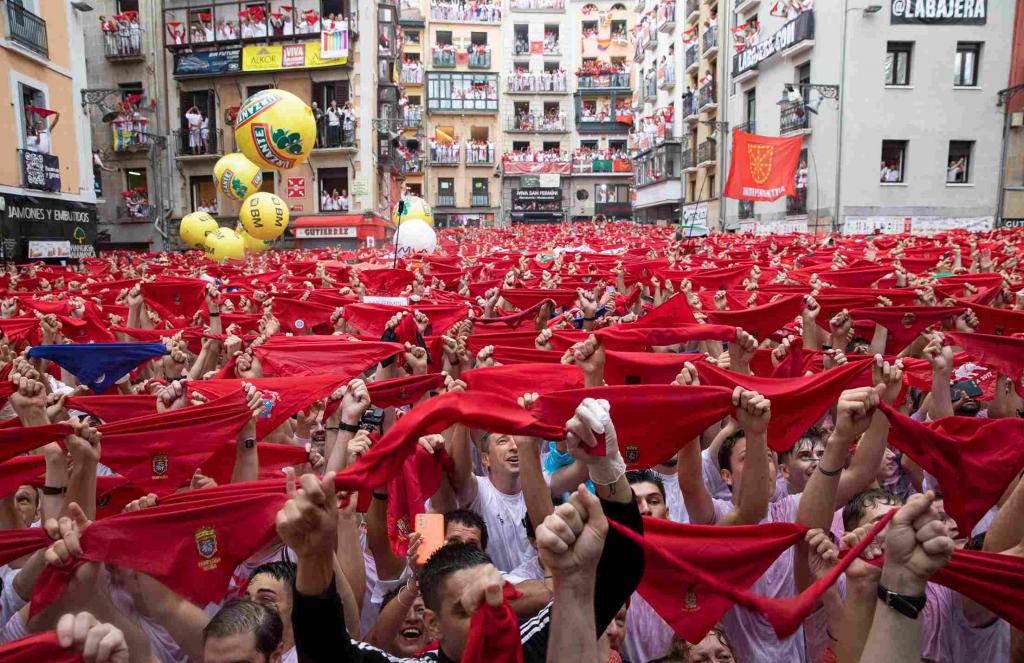Thessaloniki gets ready for its metro launch in November
The underground rapid transit lines have been under construction for almost two decades due to various project delays
 TheMayor.EU logo
TheMayor.EU logo 
Attendees wait for the Chupinazo rocket, before tying the traditional red kerchiefs on their necks, Source: Ayuntamiento de Pamplona
Watch the rocket launch to the festivities from a bird’s eye view
After a two-year suspension, the iconic Sanfermines festival is back in Pamplona painting the streets with people dressed in white and red. Exactly at midday today, Juan Carlos Unzué, a former football manager and native of the city, lit the fuse of the Chupinazo rocket from the balcony of the Town Hall. The act traditionally symbolizes the start of the nine-day festivities in the Navarrese capital.
With the traditional greeting of “Víva San Fermín, Gora San Fermín!” ('Long live San Fermin' in Spanish and in Basque), Juan Carlos Unzué gave the start of the long-awaited and much-missed festival - the most globally recognized cultural marker of Pamplona. Mr Unzué suffers from amyotrophic lateral sclerosis (ALS) and he used his moment as a ceremonial master to dedicate this year’s festivities to the health workers who worked tirelessly during the pandemic, as well as to people living with ALS.
The lighting of the Chupinazo was also followed through the four giant screens placed by the Pamplona City Council in the Plaza del Castillo, the Antoniutti Park, the Plaza de los Fueros and the Paseo de Sarasate. In addition, the start of the festivities was broadcast via streaming on municipal social networks and through the municipal website. You can also see it for yourself on the video link of this article.
The San Fermin festival was famously popularized by Ernest Hemingway in his novel The Sun Also Rises. The legendary writer was quite the fan, having attended nine times himself.
Most people associate Sanfermines with the shiver-inducing Running of the Bulls on the narrow streets of the old town of Pamplona. However, the festival is much more than that. In fact, it lasts for 9 days – always from 6 until 14 July.
In between, these two days the city is filled with people celebrating the patron saint of the city and the joy of life. And it’s not just eating, drinking and shouting. There’s a full agenda of activities, including concerts, bullfights, theatre performances and more.
Then it will all end on 14 July with the collective singing of the Pobre de mí song, which means “poor me” and is a good reflection on the idea that a party must eventually end. But until then, Viva San Fermín!

The underground rapid transit lines have been under construction for almost two decades due to various project delays

Now you can get your wine in Talence by paying directly in Bitcoin

That’s because the state has to spend money on updating the railway infrastructure rather than subsidizing the cost of the popular pass

Rethinking renewable energy sources for the urban landscape

The examples, compiled by Beyond Fossil Fuels, can inform and inspire communities and entrepreneurs that still feel trepidation at the prospect of energy transition

Now you can get your wine in Talence by paying directly in Bitcoin

The 10th European Conference on Sustainable Cities and Towns (ESCT) sets the stage for stronger cooperation between the EU, national and local level to fast track Europe's transition to climate neutrality.

At least, that’s the promise made by the mayor of Paris, Anne Hidalgo

The underground rapid transit lines have been under construction for almost two decades due to various project delays

At least, that’s the promise made by the mayor of Paris, Anne Hidalgo

Hostal de Pinós is located in the geographical centre of the autonomous region

Despite its church-y name, the district has long been known as the hangout spot for the artsy crowds

Urban dwellers across the EU are having a say in making their surroundings friendlier to people and the environment.

Forests in the EU can help green the European construction industry and bolster a continent-wide push for architectural improvements.

Apply by 10 November and do your part for the transformation of European public spaces

An interview with the Mayor of a Polish city that seeks to reinvent itself

An interview with the newly elected ICLEI President and Mayor of Malmö

A conversation with the Mayor of Lisbon about the spirit and dimensions of innovation present in the Portuguese capital














